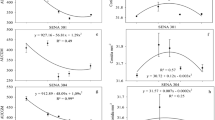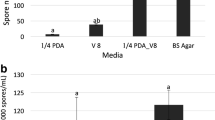Abstract
Colletotrichumgloeosporioides and C. acutatum are causal agents of grape ripe rot, but with available methods, sporulation of C.gloeosporioides on plate media has been unstable and inferior to that of C. acutatum. To facilitate studies on C. gloeosporioides, I developed an improved method to induce conidiation of this fungus. Isolates of C. gloeosporioides were pre-cultured in potato dextrose broth for 1 week, then pulverized in whole broth. The homogenate was then spread on diluted oatmeal agar (15–20% commercial oatmeal agar medium, 1.5% agar) plates. After the plates were cultured at 25°C under continuous light for another week, the C. gloeosporioides isolates sporulated stably on the plate medium.





Similar content being viewed by others
References
Baxter LW Jr, Fagan SG (1974) A simplified method of inducing asexual sporulation in Glomerella cingulata. Plant Dis Rep 58:300–303
Cooke BM, Jones DG (1970) The effect of near-ultraviolet irradiation and agar medium on the sporulation of Septoria nodorum and S. tritici. Trans Br Mycol Soc 54:221–226
Fukaya M (1995) Ripe rot. In: Ohata K, Araki T, Kiso A, Kudo A, Takahashi H (eds) Methods for isolation, cultivation, inoculation of plant pathogens (in Japanese). Japan Plant Protection Association, Tokyo, Japan, pp 257–258
Johnston PR, Jones D (1997) Relationships among Colletotrichum isolates from fruit-rots assessed using rDNA sequences. Mycologia 89:420–430
Kaiser WJ (1973) Factors affecting growth, sporulation, pathogenicity, and survival of Ascochyta rabiei. Mycologia 65:444–457
Miller SB, Baxter LW Jr (1970) Some factors influencing asexual sporulation in a strain of Glomerella cingulata pathogenic to camellias. Phytopathology 60:743–744
Namai T, Yamanaka S (1983) A component contained in oatmeal that favors the sporulation of rice blast fungus, Pyricularia oryzae Cavara (in Japanese with English summary). Ann Phytopathol Soc Jpn 49:274–276
Namai T, Yamanaka S (1985) Studies on the sporulation of rice blast fungus, Pyricularia oryzae Cavara. IV. Effect of hyphal age and culture media on sporulation. Tohoku J Agric Res 35:69–79
Noguchi Y, Mochizuki T, Yamakawa O (1994) Petiole dip inoculation is a convenient method for screening strawberry for resistance to anthracnose caused by Colletotrichum fragariae (in Japanese). Bull Natl Res Inst Veg Ornam Plants Tea Jpn A9:13–26
Ozoe S, Takuda T, Hirosawa T (1972) Studies on the etiology and the control of the ripe-rot of grapes. I. The primary occurrence of the disease and the chemical control in dormant period of grapes (in Japanese with English summary). Bull Shimane Agric Exp Stn 10:120–158
Shiraishi M, Yamada M, Mitani N, Ueno T, Nakaune R, Nakano M (2006) Rapid screening assay for ripe rot resistance in grape cultivars. J Jpn Soc Hort Sci 75:264–266
Shiraishi M, Koide M, Itamura H, Yamada M, Mitani N, Ueno T, Nakaune R, Nakano M (2007) Screening for resistance to ripe rot caused by Colletotrichum acutatum in grape germplasm. Vitis 46:196–200
Sutton BC (1992) The genus Glomerella and its anamorph Colletotrichum. In: Bailey JA, Jeger MJ (eds) Colletotrichum biology, pathology and control. CAB International, Wallingford, pp 1–26
Yamamoto J, Sato T, Tomioka K (1999) Occurrence of ripe rot of grapes (Vitis vinifera L.) caused by Colletotrichum acutatum Simmonds ex Simmonds (in Japanese). Ann Phytopathol Soc Jpn 65:83–86
Acknowledgments
I thank Drs. Mikio Shiraishi (Fukuoka Agricultural Research Center), Yukihiro Kunugi (Yamanashi Fruit Tree Experiment Station) and Kenichi Kondo (Nagano Fruit Tree Experiment Station) for valuable advice and kindly supplying fungal isolates.
Author information
Authors and Affiliations
Corresponding author
Rights and permissions
About this article
Cite this article
Suzaki, K. Improved method to induce sporulation of Colletotrichum gloeosporioides, causal fungus of grape ripe rot. J Gen Plant Pathol 77, 81–84 (2011). https://doi.org/10.1007/s10327-011-0296-z
Received:
Accepted:
Published:
Issue Date:
DOI: https://doi.org/10.1007/s10327-011-0296-z




